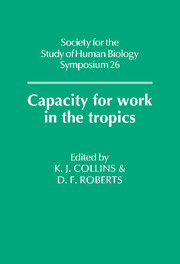Book contents
- Frontmatter
- Contents
- Preface
- Measurement of Working Capacity in Populations
- Functional Consequences of Malnutrition
- Malnutrition, work output and energy needs
- The role of working women in a rural environment when nutrition is marginally adequate: problems of assessment
- Defining anaemia and its effect on physical work capacity at high altitudes in the Bolivian Andes
- Marginal malnutrition in childhood: implications for adult work capacity and productivity
- Marginal energy malnutrition: some speculations on primary energy sparing mechanisms
- Growth, Stature and Muscular Efficiency
- Ethnic and Socio-Cultural Differences in Working Capacity
- Energy Expenditure and Endemic Disease
- Research Models in Tropical Ecosystems
- Index
Marginal malnutrition in childhood: implications for adult work capacity and productivity
Published online by Cambridge University Press: 15 March 2010
- Frontmatter
- Contents
- Preface
- Measurement of Working Capacity in Populations
- Functional Consequences of Malnutrition
- Malnutrition, work output and energy needs
- The role of working women in a rural environment when nutrition is marginally adequate: problems of assessment
- Defining anaemia and its effect on physical work capacity at high altitudes in the Bolivian Andes
- Marginal malnutrition in childhood: implications for adult work capacity and productivity
- Marginal energy malnutrition: some speculations on primary energy sparing mechanisms
- Growth, Stature and Muscular Efficiency
- Ethnic and Socio-Cultural Differences in Working Capacity
- Energy Expenditure and Endemic Disease
- Research Models in Tropical Ecosystems
- Index
Summary
INTRODUCTION
In those areas of the world which lie between the Tropics of Cancer and Capricorn, the great majority of the countries can be categorised as developing nations, where mechanisation is at a minimum and economic productivity relies heavily on human labour (Smil, 1979). In a recent listing of some 39 countries having significant deficits in the daily caloric intake of their populations, 30 countries were located in the tropics (Berg, 1981). Consequently, any discussion of physical work capacity of individuals living in the tropics must take into account the effects of undernutrition and poor nutritional status.
From data published by the United Nations (1980), it is possible to estimate the percentage of the economically active populations engaged in moderate to heavy physical work in some tropical countries (Table 1). Estimates of the number of people who are chronically undernourished vary from one in four to one in eight of the world's population (Soedjatmoko, 1981). The two-fold difference in these values reflects the difficulty of estimating the prevalence of undernutrition, but even the lowest estimate indicates the magnitude of the problem. If a direct relationship exists between nutritional status and physical work capacity and, in turn, between the latter and productivity in moderate to heavy work, the data in Table 1 would indicate a retarding effect of undernutrition on the economic development of affected populations (Berg, 1973).
In the case of children, while the prevalence of severe malnutrition has been estimated at 1 to 3 percent of the population, Bengoa and Denoso (1974) concluded that at least 10 times that figure have less severe forms.
- Type
- Chapter
- Information
- Capacity for Work in the Tropics , pp. 107 - 140Publisher: Cambridge University PressPrint publication year: 1988
- 9
- Cited by



